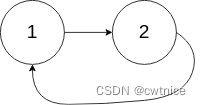-
【数据结构入门_链表】 Leetcode 141. 环形链表
原题连接:Leetcode 141.Linked List Cycle
Given head, the head of a linked list, determine if the linked list has a cycle in it.
There is a cycle in a linked list if there is some node in the list that can be reached again by continuously following the next pointer. Internally, pos is used to denote the index of the node that tail’s next pointer is connected to. Note that pos is not passed as a parameter.
Return
trueif there is a cycle in the linked list. Otherwise, returnfalse.Example 1:

Input: head = [3,2,0,-4], pos = 1 Output: true Explanation: There is a cycle in the linked list, where the tail connects to the 1st node (0-indexed).- 1
- 2
- 3
Example 2:

Input: head = [1,2], pos = 0 Output: true Explanation: There is a cycle in the linked list, where the tail connects to the 0th node.- 1
- 2
- 3
Example 3:

Input: head = [1], pos = -1 Output: false Explanation: There is no cycle in the linked list.- 1
- 2
- 3
Constraints:
- The number of the nodes in the list is in the range [0, 104].
- -105 <= Node.val <= 105
- pos is -1 or a valid index in the linked-list.
Follow up : Can you solve it using O(1) memory?
方法一:哈希表
思路:
遍历一遍链表,将遍历到的 结点 存入链表中,如果重复就返回true
注意 : 哈希表中一定要存结点而不是结点的值。因为链表中不同结点的值可能相同,但他们不是同一个结点c++代码:
/** * Definition for singly-linked list. * struct ListNode { * int val; * ListNode *next; * ListNode(int x) : val(x), next(NULL) {} * }; */ class Solution { public: bool hasCycle(ListNode *head) { if(!head || !head->next) return false; unordered_set<ListNode*> st; while(head != nullptr){ if(st.count(head)) return true; st.insert(head); head = head->next; } return false; } };- 1
- 2
- 3
- 4
- 5
- 6
- 7
- 8
- 9
- 10
- 11
- 12
- 13
- 14
- 15
- 16
- 17
- 18
- 19
- 20
- 21
- 22
- 23
- 24
复杂度分析:
- 时间复杂度:O(n),需要遍历一遍链表
- 空间复杂度:O(n),哈希表最多存整个链表的元素
方法二:快慢指针
思路:
Floyd 判圈算法,也龟兔赛跑算法:
设置快慢两个指针,慢的一次移动一位,快的一次移动两位,如果存在环,那么快的指针一定会从后面追上慢的指针c++代码:
/** * Definition for singly-linked list. * struct ListNode { * int val; * ListNode *next; * ListNode(int x) : val(x), next(NULL) {} * }; */ class Solution { public: bool hasCycle(ListNode* head) { if (!head || !head->next) { return false; } // 注意此处fast的起点 ListNode* slow = head; ListNode* fast = head->next; while (slow != fast) { // 如果有指针先到NULL说明无环 if (!fast || !fast->next) { return false; } // 慢指针移动一位 快指针移动两位 slow = slow->next; fast = fast->next->next; } return true; } };- 1
- 2
- 3
- 4
- 5
- 6
- 7
- 8
- 9
- 10
- 11
- 12
- 13
- 14
- 15
- 16
- 17
- 18
- 19
- 20
- 21
- 22
- 23
- 24
- 25
- 26
- 27
- 28
- 29
- 30
复杂度分析:
- 时间复杂度:O(n),不存在环的时候,指针一共会移n次(两个指针各自移动n/2,快指针到达终点);存在环的时候,每一轮移动后,快慢指针的距离将减小一。而初始距离为环的长度,因此至多移动 n 轮。
- 空间复杂度:O(1),两个指针
-
相关阅读:
数据库高可靠,轻松解决事务丢失问题
安卓12手机不能安装问题记录
代码随想录算法训练营第42天|动态规划:01背包理论基础、动态规划:01背包理论基础(滚动数组)、416. 分割等和子集
Windows server 2003安装IIS教程怎么安装iis?win2003 iis服务器实验报告
axios
迭代器的使用
我的创作纪念日 | 软件测试成长之路
Thymeleaf页面布局
贪心算法找零问题
SpringCloud入门详细教程二(Nacos配置管理,http客户端Feign,统一网关Gateway)
- 原文地址:https://blog.csdn.net/cwtnice/article/details/125516717
